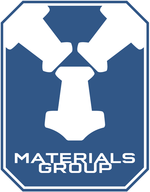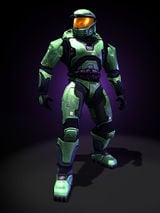Materials Group
From Halopedia, the Halo wiki
Materials Group is a division of the Office of Naval Intelligence that is responsible for researching, developing, and manufacturing technologically advanced matériel. The Materials Group's most important development has been the design of the MJOLNIR Powered Assault Armor and the powered exoskeletons which preceded it,[1][2][3] as well as several specialized variant models.[4][5][6][7][8][9]
Known projects
XRP12 Gremlin
During the early years of the Insurrection in the late 25th century, Materials Group developed the X23 Non-Nuclear Electromagnetic Pulse Cannon, which was designed to disable weapons of mass destruction before detonation. Though this technology had existed since the 20th century, the X23 was the first truly precise application of the technology. Once Materials Group deemed that the X23 was a viable tool, it was mounted on a transport chassis; this resulted in the creation of the XRP12 Combat Support Vehicle, commonly known as the Gremlin.[10]
Project: YGGDRASIL
 This section needs expansion. You can help Halopedia by expanding it.
This section needs expansion. You can help Halopedia by expanding it.
MJOLNIR Powered Assault Armor
- Main article: MJOLNIR Powered Assault Armor
Unimpressed with previous attempts at producing powered exoskeletons but requiring a battle suit to complement her Spartan-IIs, Catherine Halsey sought to develop an entirely new battle suit from the ground up. Working with Materials Group, she founded Project: MJOLNIR to achieve this aim, which Halsey felt was the realization of the goals of previous failed power armour and exoskeleton projects.[1][11][12] However, MJOLNIR, rather than being a bulky powered exoskeleton, would be a self-contained, nearly form-fitting body suit; it would augment the wearer's physical abilities to superhuman levels, though it would require dangerous genetic modification to function safely. The first production model of MJOLNIR was developed at Materials Group's Damascus Materials Testing Facility on Chi Ceti IV, and was introduced to the recently graduated Spartans on November 27, 2525.
Halsey intended for MJOLNIR to remain a single, continuous system that would be incrementally updated as upgrades became available. However, in 2535, Materials Group required that a generational categorisation system be introduced for the MJOLNIR armour, for the purposes of serialisation and prioritisation, and as a means of fiscal oversight. While Halsey was displeased with the mandate, she chose to comply in order to "keep the accountants out of [her] hair and her work", though she noted that she still intended to treat MJOLNIR as an evolving platform, with the categorisation system existing to make it seem neater on paper.[13]
Consequently, the history and future of MJOLNIR was divided into discrete numbered classes. First, Marks I, II and III referred to three prototype iterations before the first production model. Next, all production models of MJOLNIR were grouped under the Mark IV banner, given their similar specifications. Finally, Halsey laid out a prospective roadmap of specifications for three future iterations, Mark V, Mark VI and Mark VII, though she expected these specifications to be mutable depending on time, budget and other limitations that could crop up.[13] Materials Group continued to develop the main MJOLNIR series, resulting in several superficially distinct versions which, despite their drastically different appearances, were all classified as Mark IV due to their internal architecture.[14]
On November 24, 2551, the Mark V generation was introduced.[2][15] This version featured energy shielding technology, which was previously thought to be impossible to reverse-engineer from Covenant technology. It also introduced the ability to accommodate a starship-grade smart artificial intelligence. In late 2552, the Mark VI was introduced. Though it offered few groundbreaking improvements over the Mark V, aside from an automated biofoam injection system, numerous components were refined, making the Mark VI among the most powerful pieces of technology ever created by humanity.
Following the end of the Human-Covenant War the Mark VI was quickly replaced by MJOLNIR GEN2.[16] While the MJOLNIR Mark VII was produced it was not as cost effective or versatile as the GEN2 platform.[17]
MJOLNIR variants
In addition to the main MJOLNIR series, Materials Group developed several purpose-specific variants. Though several other variants have been produced, they were designed by private defense contractors, not by Materials Group.
MJOLNIR Powered Assault Armor [GEN1]
- MJOLNIR Powered Assault Armor/Mark IV
- Grenadier variant - Developed from early prototypes of the original MJOLNIR (later Mark IV) helmet. Provides superior armor and improved heads-up display to improve performance of grenadiers.[6]
- EOD variant - Designed to increase survivability when in close proximity to an explosion. Developed and manufactured at the Damascus Materials Testing Facility, the development site of the original MJOLNIR.[4]
- EVA variant - One of the earliest MJOLNIR variants. Designed to aid Spartans' mobility, field of view, and endurance during extra-vehicular activity. Developed and manufactured at Materials Group's Low/Zero Gravity Testing Facility in Lister, Aigburth, Ganymede.[5]
- MJOLNIR Powered Assault Armor/Mark V
- Grenadier variant
- HAZOP variant - Introduced as a variant of the Mark V system. Designed to improve survivability in extremely hazardous environments. Prototypes were fielded in the years prior to launch.[7]
- Recon variant - Designed to improve stealth by reducing infrared signature and Čerenkov radiation emissions. Developed at the Beta-5 Division's Ordnance Testing Facility in Swanbourne, Western Australia, parallel to the S variant.[8] After the Human-Covenant War, the Imbrium Machine Complex took ownership of Recon production.
- Scout variant - Designed to improved stealth by reducing infrared signature and Čerenkov radiation emissions. Developed at B5D Ordnance Testing Facility in Swanbourne, Western Australia, parallel to the Mark VI/R variant.
- MJOLNIR Powered Assault Armor/Mark VI
- EOD variant
- EVA variant
- Scout variant
- Recon variant
- Project HAYABUSA - Originally an independent powered armor project by the RKD think-tank, a MJOLNIR-compatible HAYABUSA variant was later developed after Materials Group contacted and pooled resources with RKD.
- MJOLNIR Powered Assault Armor/Mark VII - The fourth and most recent major iteration of the MJOLNIR Powered Assault Armor [GEN1]. The armor's cost led it to be phased out of production.
MJOLNIR Powered Assault Armor [GEN2] - The second generation of MJOLNIR armor, replacing GEN1 (Mark IV-VII)
- Decimator variant
- EVA variant
- Protector variant
- Scanner variant
- Scout variant
- Soldier variant
- Warrior variant
MJOLNIR Powered Assault Armor (GEN3) - The third generation of MJOLNIR armor, replacing the former two MJOLNIR generations.
- Mark V Zeta variant - Spartans assigned to ONI's Xeno-Materials Exploitation Group on Installation 07 found that their upgraded Mark V's mix of high-threat response and surveillance interlinks were ideal for the ring's peculiar operating environment.[18]
- Mark VI variant - In early 2559, in the midst of the Created conflict, the Mark VI has been upgraded to the GEN3 platform.[19]
- Mark VII variant - Though the GEN3 model of Mark VII MJOLNIR does represent a generational leap for the MJOLNIR platform for actively deployed Spartans, some elements tested with the GEN1 and GEN2 Mark VII remain in the prototype stage due to unreliability or cost factors, such as integration of Forerunner-derived nanomachine elements and full shield-shaping.[20]
- Soldier variant - The latest iteration of the Soldier helmet features a new revision of Materials Group's combat catalyst firmware. The fireteam synchronization features remain unfinished circa 2560, but Dr. Halsey's interest may accelerate development.[21]
Known facilities
- Damascus Materials Testing Facility - When this facility was attacked by the Covenant vessel Unrelenting on November 27, 2525, the SPARTAN-IIs were deployed to destroy the ship, resulting in the death of Samuel-034. The Covenant then deployed a science lance to the facility to retrieve any useful technology,[22] though this incursion was seemingly unsuccessful, as Materials Group held the facility throughout the Human-Covenant War.[6] The Damascus facility's staff developed both the EOD and Grenadier variants of the MJOLNIR system.
- Beta-5 Division Ordnance Testing Facility - This facility was responsible for the parallel development of the Scout and Recon variants of the Mark VI MJOLNIR armor.
- Low/Zero Gravity Testing Facility - This facility developed and manufactured the MJOLNIR EVA variant after the Summa Deep Space Incident, prompting a desire to improve performance in limited-gravity/evacuated environments.[5]
- Weapons Research Facility T12A - This facility's HRUNTING research team was responsible for the development of the HRUNTING Mark III (B) Exoskeleton, commonly known as the Cyclops. Later, HRUNTING was merged with Project YGGDRASIL, leading to the development of the HRUNTING/YGGDRASIL Mark I Prototype Armor Defense System. This facility was attacked by the Covenant during or after 2548, and was destroyed when a sergeant from the UNSC Marine Corps of Engineers activated the self-destruct sequence of the only known HRUNTING/YGGDRASIL suit, killing the invading Covenant forces.[11][23]
- WG/Facility 58-32/B5D - This facility is used to test several GEN2 Mjolnir armor.
- Unidentified facility - This facility is responsible for manufacturing of GEN3 Mjolnir armor.
Gallery
List of appearances
- Halo: The Fall of Reach (First appearance)
- Halo 3 (Indirect mention)
- Halo Legends
- Halo: Reach (Indirect mention)
- Halo: Fall of Reach
- Halo 4
- Halo: Nightfall (Mentioned only)
- Halo 5: Guardians (Indirect appearance)
- Halo: Silent Storm (Mentioned only)
- Step Inside
- Halo Infinite (Mentioned only)
Sources
- ^ a b Halo: The Essential Visual Guide, page 118
- ^ a b Halo: The Essential Visual Guide, page 119
- ^ Halo: The Essential Visual Guide, page 120
- ^ a b Halo: The Essential Visual Guide, page 65
- ^ a b c Halo: The Essential Visual Guide, page 66
- ^ a b c Halo: The Essential Visual Guide, page 85
- ^ a b Halo: The Essential Visual Guide, page 92
- ^ a b Halo: The Essential Visual Guide, page 152
- ^ Halo: The Essential Visual Guide, page 165
- ^ Halo: The Essential Visual Guide, page 83
- ^ a b Halo: The Essential Visual Guide, page 44
- ^ Halo: The Fall of Reach, page 115 (2001 edition), page 137 (2010 edition)
- ^ a b Dr. Halsey's personal journal, January 7, 2535
- ^ Halo Waypoint: The MJOLNIR Project Part 2
- ^ Bungie.net: Bungie Weekly Update - 1/29/10
- ^ Halo: Initiation
- ^ Halo Waypoint: MJOLNIR
- ^ Halo Waypoint, Canon Fodder - Parallel Threads (Retrieved on Jun 25, 2021) [archive]
- ^ Step Inside
- ^ Halo Waypoint, Canon Fodder - Despite Distance (Retrieved on Jun 27, 2021) [archive]
- ^ Halo Waypoint, Canon Fodder - Showcase Sensitive (Retrieved on Jun 27, 2021) [archive]
- ^ Halo Wars timeline
- ^ Halo Legends, Prototype





